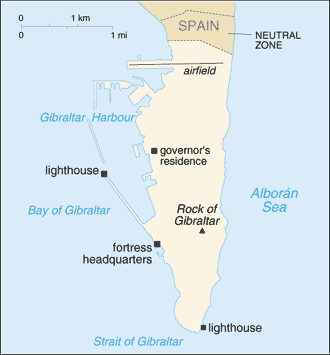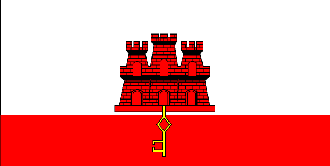
|
Gibraltar
Background:
Strategically important, Gibraltar was ceded to Great Britain by
Spain in the 1713 Treaty of Utrecht; the British garrison was formally declared
a colony in 1830. In a 1967 referendum, Gibraltarians ignored Spanish pressure
and voted overwhelmingly to remain a British dependency.
Location:
Southwestern Europe, bordering the Strait of Gibraltar, which links
the Mediterranean Sea and the North Atlantic Ocean, on the southern coast of
Spain.
Area: Total: 6.5 sq km.
Area - comparative: About 11 times the size of The Mall in Washington, DC.
Land boundaries: Total: 1.2 km, border countries: Spain 1.2 km.
Coastline: 12 km.
Climate and Terrain:
Climate: Mediterranean with mild winters and warm summers
Terrain: A narrow coastal lowland borders the Rock of Gibraltar
Elevation extremes: Lowest point: Mediterranean Sea 0 m, highest point: Rock
of Gibraltar 426 m.
Land use: Arable land: 0%.
People:
Population: 27,649.
Ethnic groups: Spanish, Italian, English, Maltese, Portuguese.
Religions: Roman Catholic 76.9%, Church of England 6.9%, Muslim 6.9%, Jewish
2.3%, none or other 7%.
Languages: English (used in schools and for official purposes), Spanish,
Italian, Portuguese, Russian.
Labor force: 14,800.
Labor force - by occupation: Services 60%, industry 40%.
Industries: Tourism, banking and finance, ship-building and repairing; support
to large UK naval and air bases; tobacco, mineral water, beer, canned fish.
Agriculture - products: None.
Government:
Government type: Republic.
Capital: Valletta.
Economy overview:
Gibraltar benefits from an extensive shipping trade,
offshore banking, and its position as an international conference center. The
British military presence has been sharply reduced and now contributes about
11% to the local economy. The financial sector accounts for 20% of GDP; tourism
(almost 6 million visitors in 1998), shipping services fees, and duties on
consumer goods also generate revenue. In recent years, Gibraltar has seen major
structural change from a public to a private sector economy, but changes in
government spending still have a major impact on the level of employment.
Statistics:
Telephones - main lines in use: 19,000.
Telephones - mobile cellular: 1,620.
Radio broadcast stations: AM 1, FM 5.
Radios: 37,000.
Television broadcast stations: 1 (plus three low-power repeaters).
Televisions: 10,000.
Highways: Total: 46.25 km, paved: 46.25 km.
Airports - with paved runways: Total: 1.
Return to Visiting Locations
|

